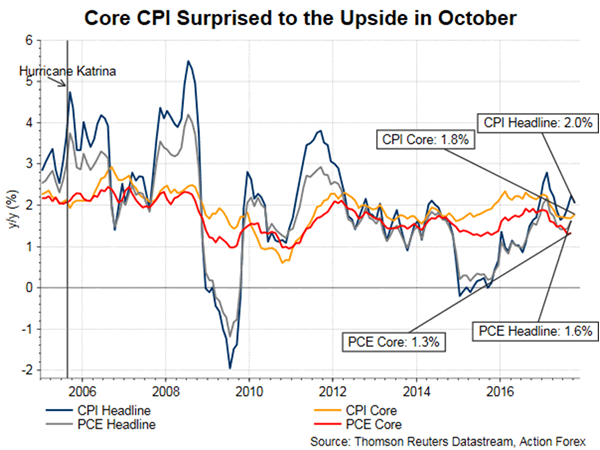The latest testimonies of both the incoming and outgoing Fed chairs suggest that the FOMC’s approach would be more the less the same after February next year. At his confirmation hearing before the Senate, Jerome Powell affirmed that future monetary policy would remain data-dependent. He also added that the case for ‘raising interest rates at our next meeting is coming together’, as economic conditions warrant, but future rate hikes can ‘go more slowly’ if inflation has stayed low. On balance sheet normalization, Powell noted that the balance sheet is expected to be trimmed to a range between US$ 2.5-3 trillion over the next few years. It is believed that Powell would continue with Janet Yellen’s legacy. Meanwhile, Yellen told the Congress Joint Economic Committee, that ‘the economic expansion is increasingly broad based across sectors as well as across much of the global economy’. She added that ‘with gradual adjustments in the stance of monetary policy, the economy will continue to expand and the job market will strengthen somewhat further, supporting faster growth in wages and incomes’. Indeed, both Powell and Yellen are believed to be in the centre-dovish camp, although Powell had been classified as a hawk as he had urged the then chair Ben Bernanke to unwind the QE program.
We notice that rate hike speculations have increased slightly in March 2018. Meanwhile, the market has raised speculations that the Fed would raise the policy rate by more than +25 bps (though the overwhelming majority remains +25 bps). We believe the hawkishness has been driven by the clearing of one more hurdle by the Senate, coupling with the Beige Book report suggesting strengthening in inflationary pressure.
Beige Book
Let’s take a look at the latter first. The Beige Book prepared by the St Louis Fed described the economic activity as continuing ‘to increase at a modest to moderate pace in October and mid-November’. The report suggested that ‘all Districts reported that manufacturing activity expanded, with most describing growth as moderate’. For the job market, employment increased tightness in the labour market were ‘widespread’, with ‘most’ Districts reporting difficulty in finding qualified workers across various skill levels, and ‘several’ Districts reporting an inability to find workers with the required skills. Yet, wage growth remained ‘modest or moderate’ in most Districts. On inflation, the Beige Book indicated that ‘price pressures have strengthened since the last report. Most Districts reported modest to moderate growth in selling prices and moderate increases in non-labor input costs’.

US Tax Reform Plan Update
The Senate Budget Committee approved (voted 12-11) the Republican tax plan Tuesday, paving the way for the Senate floor vote later this week. Despite criticism of the plan and proposal to include a provision in the bill that would trigger tax hikes in case of large revenue shortfalls, Republican Senators Johnson of Wisconsin and Corker of Tennessee eventually did not objected the bill. President Donald Trump noted that he has anticipated a lot of adjustments of the final plan. Yet, he remained confident that ‘the end result will be very, very massive’. He also suggested that his openness to the proposal by Senator Corker. However, Senator Kennedy of Louisiana has expressed opposition to that.
Pay attention to how it goes after the Senate floor vote later in the week! While not an easy task with Republicans only having a slim 2-seat majority, passage of the bill would be another step forward. By then, the House might decide whether to take Senate’s proposal or to seek reconciliation of the two versions, which would lengthen the final approval.













